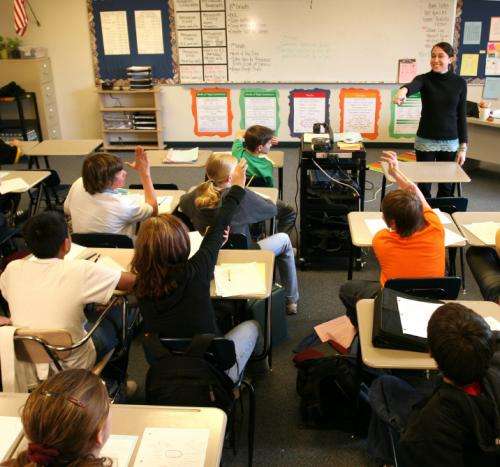ID great teaching through classroom observations, student surveys and achievement gains, researchers say

There are approximately 3.9 million teachers in the United States. These teachers interact with tens of millions of students a year, and yet there is not a widely accepted standard to evaluate their daily work of educating the future of America.
Recognizing this, the Bill and Melinda Gates Foundation funded a multi-year, $45 million study, the Measures of Effective Teaching Project, and released its third and final set of findings this month.
Researchers from the University of Virginia, along with several other universities and the Educational Testing Service, analyzed data from 3,000 teachers and their students in Charlotte, N.C.; Dallas; Denver; Memphis, Tenn.; New York; Pittsburgh; and Hillsborough County, Fla.
Bridget Hamre, U.Va. research associate professor in the Curry School of Education and associate director of the Center for Advanced Study of Teaching and Learning, or CASTL, worked with Bob Pianta, dean of the Curry School and founding director of CASTL; Lauren Carter, previous project coordinator for the Measures of Effective Teaching study; and Chris Hafen, CASTL research scientist and the managing director for MyTeachingPartner-Secondary Project on assessing teachers in the classroom for this study.
"One of the major goals of the MET study was to conduct observations of teaching across grades and content areas," Hamre explained. "U.Va. was identified as a partner in this work due to our long history of conducting classroom observations using the Classroom Assessment Scoring System, or CLASS.
"Our team, in particular, was responsible for training large numbers of raters online – as well as to provide daily calibration checks on their performance. So we master-coded hours of classroom video footage and also provided consultation throughout the project as to study design and implementation."
Designed by Pianta, CLASS is an observational instrument used to assess classroom quality by effectively measuring teacher-student interactions. It has versions for use with infants through high school seniors. Using the tool, a certified CLASS observer conducts four cycles of 15-minute observations assessing teachers and students interactions. Those observations are then rated using a manual of standardized behaviors and responses.
But it's not just about measurement, Hamre said. It's about enhancing the overall relationship between teachers and students.
"Teachers are being held accountable for demonstrating that they are able to support student learning," she said. "Our argument has always been that although this type of accountability is important, we also have to be able to provide teachers with feedback and support around their teaching practices. Simply knowing that students are or are not learning is not sufficient. Teachers need to know what they can do to best support learning on a daily basis.
"This study helped to move the conversation of teacher evaluation to include other measures – classroom observations and students' reports."
The results from the MET project found that the best way to identify great teaching is to combine multiple types of measurement, including classroom observations, student surveys and student achievement gains.
While the study makes great progress toward finding an effective, holistic method of evaluating teaching, Hamre does urge caution when looking at the study as a whole.
"Many of the recommendations they make are not well-aligned with what most schools are able to do," Hamre said. "For example, few schools have the resources to observe teachers four times a year. It's challenging because data from this study demonstrate that you need to observe multiple times to achieve reliable estimates of teachers' performance.
"To support meaningful improvements in today's schools, we have to take seriously the challenges that teachers face each day in the classroom and devote sufficient resources to providing teachers with effective professional development."
Provided by University of Virginia
















